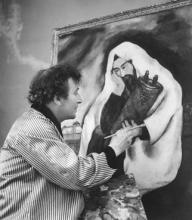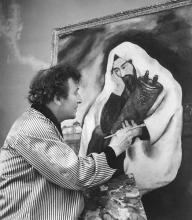Marc Chagall

Growing up as a Christian in the U.S., I was told that Jesus came to die on the cross for our sins and establish the Christian religion. It’s embarrassing to admit, and stands as an example of the way in which casual antisemitism saturates Christianity, but it was not until my college years, after encountering Chagall, that I realized Jesus was distinctly Jewish and that Jews had been offering unique and refreshing ways to see Jesus throughout history.
Writer, art curator, and expert, Aaron Rosen is continuing that tradition, offering new ways to see Jesus from his context as a practicing Jew by inviting people to imagine Jesus as a visual thinker. Aptly titled What Would Jesus See, Rosen’s book encourages people of all backgrounds — Christian, Jewish, or no religion at all — to imagine “how Jesus saw, what he saw, and why this is important today.” The shift from “What would Jesus do?” to “What would Jesus see?” may seem like a way to deemphasize Jesus’ actions. But as Rosen writes: “For Jesus, seeing was doing. At the core of his short ministry was a recurring call to look at the world—and especially its most disadvantaged denizens—with new eyes.”

Novelist Chaim Potok captured the strain of transition from religious traditionalism to artistic expression in the fictional character Asher Lev. Asher, a young painter prodigy and son of a Hasidic luminary, is drawn to a Brooklyn museum where he surreptitiously views crucifixions and nudes. He then goes on to paint such scenes.
Asher’s mother tries to understand her son’s artistic longings, yet says in exasperation, “Your painting. It’s taken us to Jesus. And to the way they paint women. Painting is for goyim, Asher. Jews don’t draw and paint.”
Asher responds, “Chagall is a Jew,” but his mother cuts him off.
“Religious Jews, Asher. Torah Jews. Such Jews don’t draw and paint.”
Returning from a trip to Europe, Asher’s father sees the crucifixion drawings. In a rage, he asks his son if he knows “how much Jewish blood had been spilled because of that man?”

At a moment when the world is flush with new books and ever-evolving interpretations of Jesus, one of the last century’s artistic masters is providing art lovers with a striking take on the first-century religious figure.
The first U.S. exhibition exploring the “darker works” of Marc Chagall (1887-1985) shows a Jewish artist obsessed with Jesus.
“Chagall: Love, War, and Exile,” at The Jewish Museum in New York showcases the work of the Russian-French artist during World War II as he tried to make sense of a world gone mad.
Of particular interest are paintings depicting the crucified Jesus — depictions that are often read as metaphors not only for war but the particular expressions of Jewish suffering and persecution in Europe during the 1930s and 1940s.